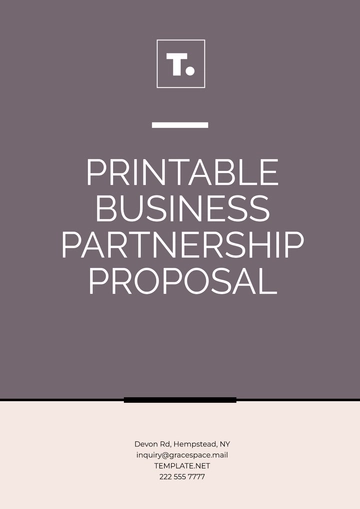Free Real Estate Partnership Proposal

I. Executive Summary
A. Overview
[Your Company Name], a renowned leader in the real estate industry, is thrilled to present this proposal for a strategic partnership with [Partner Company Name]. This partnership aims to synergize our strengths and resources to create a formidable force in the real estate market, driving innovation and growth.
With [Your Company Name]'s extensive experience and proven track record in the real estate sector, including successful project completions, and client satisfaction ratings, we bring invaluable expertise to the table.
The proposed partnership with [Partner Company Name] offers a unique opportunity to combine our market knowledge and client-centric approach with their technological solutions and operational efficiency, paving the way for enhanced service offerings, expanded market reach, and increased profitability for both entities.
B. Key Points
[Your Company Name] boasts a distinguished reputation built on:
Decades of industry experience
High client satisfaction rates
Innovative marketing and sales strategies
The partnership endeavors to:
Integrate [Partner Company Name]'s cutting-edge technology solutions to streamline operations and enhance client experiences.
Expand into new markets and demographic segments, leveraging our combined strengths.
Achieve a combined revenue target of [$10,000,000] within the next [5] years.
Benefits of the partnership encompass:
Access to state-of-the-art technology platforms
Shared resources and expertise
Diversification of service offerings and revenue streams
II. Introduction
A. Background
[Your Company Name], established in [year of establishment], has been a prominent figure in the real estate landscape, specializing in residential, commercial, and luxury properties. Our commitment to excellence and integrity has earned us the trust of clients and partners alike.
With a mission to deliver exceptional real estate experiences and exceed client expectations, [Your Company Name] has consistently surpassed industry standards and set new benchmarks for success.
B. Purpose of Proposal
This proposal aims to formalize a strategic partnership between [Your Company Name] and [Partner Company Name] to leverage our respective strengths and resources for mutual benefit. By aligning our goals and objectives, we seek to create value and drive sustainable growth in the real estate market.
III. Partnership Details
A. Objectives
The primary objectives of the proposed partnership between [Your Company Name] and [Partner Company Name] are as follows:
Objective | Description |
|---|---|
Expand Market Reach | Enter new geographical markets and demographic segments to increase market penetration. |
Enhance Service Offerings | Integrate [Partner Company Name]'s technology solutions to offer enhanced services to clients. |
Increase Revenue Streams | Collaborate on joint marketing and sales efforts to drive revenue growth and achieve targets. |
B. Scope of Partnership
The partnership will entail the following scope of collaboration:
Collaboration Area | Responsibilities |
|---|---|
Technology Integration | [Your Company Name] will work with [Partner Company Name] to integrate their customer relationship management (CRM) software into our operations, enhancing efficiency and client experiences. |
Market Expansion | Jointly identify target markets and develop strategies to enter new regions, leveraging each other's networks and resources. |
Revenue Generation | Collaborate on marketing campaigns and sales initiatives to generate revenue, with a focus on cross-selling opportunities and bundled services. |
C. Governance Structure
The governance structure of the partnership will consist of:
Joint Steering Committee: Comprising representatives from both [Your Company Name] and [Partner Company Name] to oversee strategic decision-making and ensure alignment with objectives.
Regular Review Meetings: Scheduled at predefined intervals to assess progress, address challenges, and make necessary adjustments to the partnership strategy.
IV. Financial Projections
A. Revenue Projections
[Your Company Name] forecasts the following revenue projections as a result of the partnership with [Partner Company Name]:
Year | Projected Revenue (USD) |
|---|---|
Year 1 | [$2,000,000] |
Year 2 | [$3,500,000] |
Year 3 | [$5,000,000] |
These projections are based on factors such as market analysis, historical performance, and anticipated synergies from the partnership.
B. Investment Requirements
The initial investment required from each party for the partnership is as follows:
Investment Type | [Your Company Name] | [Partner Company Name] |
|---|---|---|
Financial Contribution | [$500,000] | [$700,000] |
Resources | Marketing team, | Technology development, |
Sales team | CRM software |
These investments will be allocated towards technology integration, market expansion initiatives, and joint marketing efforts as outlined in the partnership agreement.
V. Marketing and Sales Strategy
A. Target Market Analysis
Identifying and analyzing target demographics and segments is crucial for effective marketing and sales strategies. The following steps will be taken:
Market Research: Conduct comprehensive market research to identify potential target demographics and segments.
Data Analysis: Analyze market trends, demand drivers, and competitive landscape to gain insights for targeting.
B. Marketing Plan
The marketing plan will focus on leveraging the strengths of both [Your Company Name] and [Partner Company Name] to create impactful campaigns:
Integrated Campaigns: Develop integrated marketing campaigns combining traditional and digital channels for maximum reach and impact.
Content Creation: Create compelling content, including blog posts, videos, and infographics, to engage and educate the target audience.
C. Sales Strategy
A robust sales strategy will be implemented to drive revenue generation and client acquisition:
Targeted Sales Efforts: Utilize targeted sales efforts to reach key decision-makers and stakeholders in potential client organizations.
Relationship Building: Foster strong relationships with clients through personalized interactions and exceptional service delivery.
VI. Risk Management
A. Identification of Risks
Identifying potential risks and challenges is essential for effective risk management. The following risks have been identified:
Market Volatility: Fluctuations in the real estate market may impact demand and pricing, affecting revenue projections.
Technological Risks: Dependence on technology solutions may pose risks such as system failures or cybersecurity breaches.
B. Mitigation Strategies
Developing mitigation strategies to address identified risks is imperative for ensuring business continuity:
Diversification of Investments: Diversify investment portfolios to mitigate the impact of market volatility on revenue streams.
Implementing Security Measures: Implement robust cybersecurity measures and protocols to safeguard against technological risks.
C. Compliance and Governance
Ensuring compliance with regulatory requirements and industry standards is vital for risk management:
Regulatory Compliance: Adhere to all relevant laws and regulations governing real estate operations to mitigate legal risks.
Internal Controls: Implement internal controls and procedures to ensure adherence to company policies and standards.
VII. Legal and Governance
A. Partnership Agreement
Drafting a comprehensive partnership agreement is essential to establish the legal framework for the collaboration between [Your Company Name] and [Partner Company Name]. Key provisions of the partnership agreement will include:
Definition of Roles and Responsibilities: Clearly outline the roles and responsibilities of each party, including decision-making authority, contribution expectations, and obligations.
Financial Arrangements: Specify the terms of revenue sharing, investment commitments, and financial responsibilities of each party, ensuring transparency and fairness.
Dispute Resolution Mechanisms: Establish procedures for resolving disputes or conflicts that may arise during the course of the partnership, promoting amicable resolutions and minimizing disruptions.
Confidentiality and Non-disclosure: Include provisions to protect sensitive information and proprietary data shared between the parties, safeguarding intellectual property and maintaining confidentiality.
Termination Clauses: Define conditions under which the partnership may be terminated, including breach of agreement, insolvency, or changes in business circumstances, providing clarity on exit strategies and liabilities.
B. Regulatory Compliance
Compliance with regulatory requirements is paramount to ensure the legality and legitimacy of the partnership. [Your Company Name] and [Partner Company Name] will:
Due Diligence: Conduct thorough due diligence to assess compliance with relevant laws, regulations, and industry standards governing real estate partnerships, identifying any potential areas of non-compliance or risk.
Legal Review: Engage legal counsel with expertise in real estate law to review and finalize the partnership agreement, ensuring that all contractual provisions adhere to applicable legal requirements and mitigate potential legal risks.
Documentation and Reporting: Maintain accurate records and documentation to demonstrate compliance with regulatory requirements, including licensing, permits, and regulatory filings, facilitating transparency and accountability.
VIII. Conclusion
A. Summary of Benefits
The proposed partnership between [Your Company Name] and [Partner Company Name] offers numerous benefits, including:
Access to Innovative Technology Solutions: Leveraging [Partner Company Name]'s technology solutions to enhance operational efficiency, streamline processes, and deliver superior client experiences.
Expanded Market Reach and Client Base: Combining [Your Company Name]'s market expertise and [Partner Company Name]'s resources to penetrate new markets, reach untapped demographic segments, and broaden the client base.
Enhanced Service Offerings and Revenue Streams: Integrating complementary services and expertise to offer comprehensive solutions, capitalize on cross-selling opportunities, and diversify revenue streams.
Shared Resources and Expertise: Collaborating on joint initiatives, sharing knowledge, and leveraging collective strengths to drive mutual growth, innovation, and success.
B. Next Steps
Moving forward, the next steps in the partnership process include:
Finalizing the Partnership Agreement: Reviewing and finalizing the partnership agreement, incorporating feedback, and obtaining necessary approvals from stakeholders.
Commencing Implementation Activities: Initiating the implementation of the partnership plan, executing agreed-upon strategies, and allocating resources as outlined in the partnership agreement.
Monitoring and Evaluation: Establishing mechanisms for monitoring progress, tracking performance metrics, and conducting regular reviews to assess the effectiveness of the partnership and make adjustments as needed to ensure its success.
C. Contact Information
[Your Company Name]
Address: [Your Company Address]
Phone: [Your Company Number]
Email: [Your Company Email]
Website: [Your Company Website]
[Partner Company Name]
Address: [Partner Company Address]
Phone: [Partner Company Number]
Email: [Partner Company Email]
- 100% Customizable, free editor
- Access 1 Million+ Templates, photo’s & graphics
- Download or share as a template
- Click and replace photos, graphics, text, backgrounds
- Resize, crop, AI write & more
- Access advanced editor
Boost your real estate ventures with our Real Estate Partnership Proposal Template from Template.net. This customizable document outlines collaboration terms, benefits, and shared goals. Editable in our Ai Editor Tool for seamless customization to suit your unique needs. Elevate your proposals and secure lucrative partnerships with our professional templates.
You may also like
- Business Proposal
- Research Proposal
- Proposal Request
- Project Proposal
- Grant Proposal
- Photography Proposal
- Job Proposal
- Budget Proposal
- Marketing Proposal
- Branding Proposal
- Advertising Proposal
- Sales Proposal
- Startup Proposal
- Event Proposal
- Creative Proposal
- Restaurant Proposal
- Blank Proposal
- One Page Proposal
- Proposal Report
- IT Proposal
- Non Profit Proposal
- Training Proposal
- Construction Proposal
- School Proposal
- Cleaning Proposal
- Contract Proposal
- HR Proposal
- Travel Agency Proposal
- Small Business Proposal
- Investment Proposal
- Bid Proposal
- Retail Business Proposal
- Sponsorship Proposal
- Academic Proposal
- Partnership Proposal
- Work Proposal
- Agency Proposal
- University Proposal
- Accounting Proposal
- Real Estate Proposal
- Hotel Proposal
- Product Proposal
- Advertising Agency Proposal
- Development Proposal
- Loan Proposal
- Website Proposal
- Nursing Home Proposal
- Financial Proposal
- Salon Proposal
- Freelancer Proposal
- Funding Proposal
- Work from Home Proposal
- Company Proposal
- Consulting Proposal
- Educational Proposal
- Construction Bid Proposal
- Interior Design Proposal
- New Product Proposal
- Sports Proposal
- Corporate Proposal
- Food Proposal
- Property Proposal
- Maintenance Proposal
- Purchase Proposal
- Rental Proposal
- Recruitment Proposal
- Social Media Proposal
- Travel Proposal
- Trip Proposal
- Software Proposal
- Conference Proposal
- Graphic Design Proposal
- Law Firm Proposal
- Medical Proposal
- Music Proposal
- Pricing Proposal
- SEO Proposal
- Strategy Proposal
- Technical Proposal
- Coaching Proposal
- Ecommerce Proposal
- Fundraising Proposal
- Landscaping Proposal
- Charity Proposal
- Contractor Proposal
- Exhibition Proposal
- Art Proposal
- Mobile Proposal
- Equipment Proposal
- Student Proposal
- Engineering Proposal
- Business Proposal





























